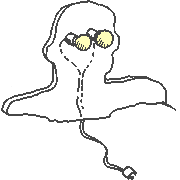|
What kind of hidden stitch would you use to repair the nose on this stuffed calico pig?
|
|
|
|

|
| # ¿ Apr 29, 2024 08:01 |
|
YggiDee posted:I'd use a ladder stitch on something like that. This worked great. Thank you! 
|
|
|
|
Hi again sewing thread, I have another thing that needs repairing. It's this wild bootleg betty boop sequined top. It's a pretty special and rare piece. Unfortunately it has a pretty big tear in it. As far as I can tell they are all still attached, and only the fabric between the sequins is what tore.  Luckily the lining doesn't have a tear in it. Both the lining and the rest of the body are made out of the same gauzy silk. It's very delicate.  I was considering finding some non fusible interfacing, putting it in between the body and lining and then going over the adjacent rows of sequins with some inconspicuous reinforcing backstitching. Maybe I'll try to put a blanket stitch on the torn edge of the fabric to keep it from unraveling. Any suggestions?
|
|
|
|
Arsenic Lupin posted:Given that it's torn along the lines of the beading, I would tend to take it in four steps. Thank you for the detailed instructions! I will get my hands on some materials and give it a shot
|
|
|
|
canyoneer posted:Gingher is originally based out of Greensboro, NC (aka "Jeansboro") and supported the huge local textiles industry. Gingher was acquired by Fiskars in bankruptcy in 2005. Pre-acquisition, they manufactured in Brazil, Italy and Germany. Post-acquisition, they make the all metal ones in Italy and the others in Taiwan. This makes dating these stamped "Made in Italy" scissors difficult. I suspect these ones are post-acquisition, 2005 or later. Cool, I never knew that Gingherís sharpening plant was in Greensboro. Iím around there a lot for work, I wonder if they would let me just drop some scissors off. I thrift around here and used to find white oak cone mills denim jeans often, which were probably samples from the plant. I was bummed when it closed down (for the most part, although they still have limited operations and manufacturing at the plant through some heritage denim foundation).
|
|
|
|

|
| # ¿ Apr 29, 2024 08:01 |
|
Lead out in cuffs posted:So my iron just died, after lasting surprisingly long (15 years) for something mid-range and made in China. I use an dry iron and spray bottle mister per some shirt-making bookís recommendation. The one I have was made by Knapp-Monarch, which isnít available anymore, but Black & Decker seems to make an identical one. Itís not perfect, and Iím not sure this technique would work for every fabric, but I prefer it to a steam iron due to it having fewer failure points.
|
|
|




